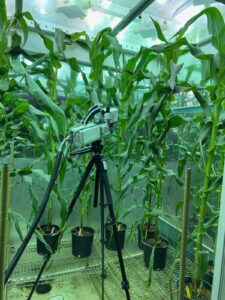 Maize is one of the world’s most widely grown crops and is essential to global food security. But like other plants, its growth and productivity can be limited by the slow activity of Rubisco, the enzyme responsible for carbon assimilation during photosynthesis. In a recent study published in the Journal of Experimental Botany, scientists from the Boyce Thompson Institute (BTI) demonstrated a promising approach to enhancing Rubisco production, thus improving photosynthesis and overall plant growth.
Maize is one of the world’s most widely grown crops and is essential to global food security. But like other plants, its growth and productivity can be limited by the slow activity of Rubisco, the enzyme responsible for carbon assimilation during photosynthesis. In a recent study published in the Journal of Experimental Botany, scientists from the Boyce Thompson Institute (BTI) demonstrated a promising approach to enhancing Rubisco production, thus improving photosynthesis and overall plant growth.
The study involved the transgenic expression of three key proteins, Rubisco Accumulation Factor 2 (Raf2) and the large and small Rubisco subunits. By overexpressing these proteins, the researchers increased Rubisco content, accelerated carbon assimilation, and boosted plant height in maize.
“Our findings demonstrate the potential of modifying Rubisco assembly to improve crop productivity,” said Kathryn Eshenour, a BTI researcher and first author of the study. “By altering the expression of these proteins, we can unlock maize’s capacity to photosynthesize more efficiently and grow more robustly, even under challenging environmental conditions.”
The research team found that Raf1 and Raf2, although acting at different steps of Rubisco assembly, could independently enhance Rubisco abundance and plant performance. This opens possibilities for further improvements by stacking the traits together, potentially leading to even greater photosynthetic capacity.
Interestingly, the transgenic plants also showed improved resilience to chilling stress, a common environmental challenge that can severely impact crop yields. The researchers observed that these plants maintained higher photosynthetic rates during cold exposure and recovered more rapidly after the stress subsided.
The team’s innovative approach holds exciting possibilities for other crops. Many staple foods with similar photosynthetic pathways to maize, such as sorghum, millet, and sugar cane, could potentially benefit from the approach used in this study, leading to improvements in photosynthetic efficiency and yield.
“This promising technology is one of several being used to enhance photosynthesis in crop plants,” said David Stern, a professor at BTI and lead author of the study. “By continuing to explore the intricacies of Rubisco assembly and its regulation, we can improve this part of a much-needed toolkit for enhancing photosynthesis across a wide range of crops.”
As food security continues to remain a pressing issue and the impacts of shifting weather patterns intensify, the need for more productive and adaptable crops has never been greater. This research highlights the transformative potential of plant science-based solutions in addressing global challenges, exemplifying BTI’s commitment to shaping a future where agriculture thrives, biodiversity is preserved, and humanity benefits from a healthier, more sustainable world.
This work was supported by the intramural research program of the U.S. Department of Agriculture, National Institute of Food and Agriculture, Physiology of Agricultural Plants, Accession No. 1022304.
